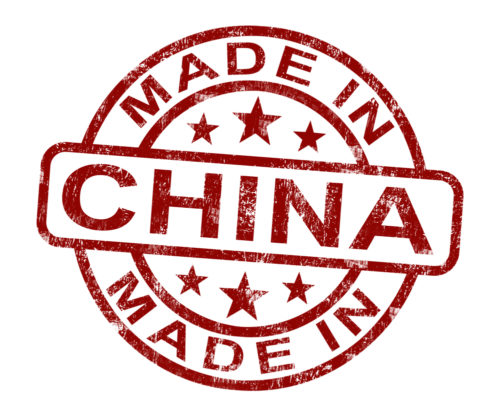In the trade war between China and the United States (which, as of this writing, is in abatement), the term “made in China” has taken on new economic and political significance. While the term has often come to refer to low-quality, mass-produced products, it also reflects America’s anxiety concerning China’s rise as a global superpower, as well as the inextricable economic ties between the two countries.
President Trump, a central figure in the current push to buy American-made goods, has himself outsourced the manufacturing of Trump Organization products to China, as well as other countries such as Bangladesh. Why are so many items made in China, and what effect does it have on the domestic and international economy? This article will help you understand the implications of buying goods made in China in the current political climate.
Table of Contents
How Products Made in China Got a Poor Reputation
The label “made in China” is often interpreted as a sign of low cost and poor quality. It is also sometimes interpreted as negative due to current trade relations with China. However, this wasn’t always the case: Chinese products were once considered valuable and unique, particularly luxury imports such as tea, furniture, and dishware. So how did Chinese-made merchandise become synonymous with cheap, poorly made, mass-produced items?
China’s Economic Growth
China has experienced rapid economic growth in the past four decades, from the 1980s to the 2020s. During this time, China emerged as a global superpower that rivaled the dominance of the United States. The country first instituted economic reforms designed to encourage economic growth in 1979, including adopting more free-market principles and opening up trade with the western world.
Because of China’s large population and low living standards when compared to other developed countries, China was able to capitalize on the abundance of low-cost labor and pursue a variety of manufacturing opportunities. According to the Congressional Research Service, manufactured products, including machinery and equipment, plastics, furniture, and nuclear reactors, boilers, and machinery are among China’s largest exports.
High-Profile Chinese-Made Product Failures
Many manufacturers in China focus on producing goods cheaply and quickly — not necessarily with an eye to quality. There have been a number of high-profile incidents involving poorly made Chinese products that have influenced the public perceptions of items made in China. While it’s a significant generalization to paint all Chinese imports with such a broad brush, these incidents have colored the way that many Americans view all goods made in China.
- Toys from China have been recalled due to issues with lead paint.
- Imported seafood has been under review for suspected use of banned drugs and chemicals.
- Toothpaste manufactured in China has been recalled due to the inclusion of dangerous chemicals.
- Pet food from China has come under scrutiny for causing illness and death in animals.
- Chinese counterfeit cosmetics were found to have harmful levels of certain chemicals and bacteria.
Impact of Buying Chinese-Made Goods
In addition to the perceived poor quality of Chinese-made goods, purchasing items made in China also has a broader impact in terms of domestic manufacturing, the economy, and trade tensions between China and the United States.
Loss of American Manufacturing Jobs
Importing cheap goods from China can lead to a reduction in manufacturing jobs in the United States. Because of China’s relatively low quality of living, they are able to manufacture goods more cheaply due to low labor costs. The same products would cost more to make in America as a result of the higher minimum wage and quality of living standards in the country.
Studies indicate that manufacturing jobs moved to China in unprecedented numbers after trade regulations were relaxed with the country, leading to job loss, layoffs, and economic precarity in areas where manufacturing was a main source of employment in the United States.
US-China Trade Imbalance
While the trade war between the United States and China has reached an uneasy truce as of February 2020, tensions still remain between the two countries. Despite an agreement reached by President Trump and President Xi JinPing to halt some tariffs, many tariffs remain in place on a wide variety of goods.
While the increased tariffs ostensibly encourage the purchase of domestic products and punish Chinese imports, in reality the results aren’t quite so clear cut. In the long run, increased tariffs on both sides of the trade war may result in higher prices across the board. Trade wars can also result in recessions when they slow economic growth.
The agreement signed by both countries has eased tensions somewhat when it comes to the trade war. However, many of the underlying conditions that led to the conflict in the first place are still in place. The United States is still dependent on China for a wide variety of raw materials and manufactured goods. Similarly, China still lags behind when it comes to technology manufacturing. The countries are closely linked economically, and as China continues to rise as a world power, future conflicts seem likely.
How Chinese Manufacturing Affects Chinese Citizens
Purchasing inexpensive Chinese-made goods may also have a negative impact on the quality of life of Chinese citizens. Chinese manufacturing has increased air pollution, resulting in illness, cancer, and early deaths for those exposed to polluted air near manufacturing centers.
At the same time, however, the meteoric growth of the Chinese manufacturing sector has helped to increase the quality of life of many Chinese citizens, with more than 850 million individuals lifted out of poverty in the last four decades. China has also reaffirmed its support of the Paris Climate Agreement and committed to reducing environmental pollution, even as the United States withdrew from the same agreement. Chinese manufacturing has ultimately been a mixed bag for Chinese citizens, bringing both environmental pollution and economic prosperity.
Alternatives to Buying Chinese-Made Goods
Because the American and Chinese economies are so tightly intertwined, it may not be feasible to try to live a life without using Chinese products. Items made in China are both affordable and ubiquitous, and their U.S.-made counterparts are often in short supply. However, there are still many good reasons to add domestic goods to your shopping list.
Buying Local or American-Made Products
If you shop for American-made goods, it can have a range of positive benefits on both the local and the national level. Shopping locally lends your support to small businesses, entrepreneurs, and local farmers and makers. Companies with a commitment to American-made goods provide jobs for their fellow Americans that might otherwise move out of the country.
In addition, consumers have greater confidence in goods made in America, and there’s a perception that American-made goods are safer and healthier. While this might not always be the case, in general America often has stricter consumer-protection regulations that help ensure that harmful chemicals or additives aren’t included in products produced in the country.
Because China and America are so closely linked on an economic level, some tension when it comes to trade and manufacturing are inevitable. As China continues to rise and assume the role of a global superpower, the United States must come to terms with the fact that they might not always be the largest and most influential economic and military power.
Image Source: https://depositphotos.com/





